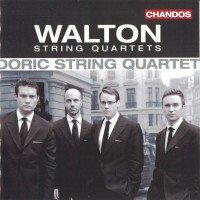 Sir William Walton was still a teenage undergraduate at Oxford when he started his first string quartet in 1919. Completed in 1922, its few performances were unsatisfactory, and despite several cuts and revisions the quartet was withdrawn by the composer. It was revived in its revised version after Walton’s death in 1983, but the Doric String Quartet performs the premiere recording of the full-length original version on Walton String Quartets (Chandos CHAN 10661). Despite the composer’s negative assessment – it was, he said, “full of undigested Bartok and Schoenberg” – it’s a fascinating and extremely challenging three-movement work, with a massive and astonishing fugal finale that isn’t out of place besides Beethoven’s Grosse Fuge. Dating from the mid-1940s, Walton’s second quartet is, not surprisingly, from a different world, and more in the language that we associate with the mature composer. There is contrapuntal skill here too, though, together with Walton’s usual lyricism. The Doric Quartet is superb in both works, and beautifully recorded. This is a significant addition to the catalogue of 20th century string quartet recordings.
Sir William Walton was still a teenage undergraduate at Oxford when he started his first string quartet in 1919. Completed in 1922, its few performances were unsatisfactory, and despite several cuts and revisions the quartet was withdrawn by the composer. It was revived in its revised version after Walton’s death in 1983, but the Doric String Quartet performs the premiere recording of the full-length original version on Walton String Quartets (Chandos CHAN 10661). Despite the composer’s negative assessment – it was, he said, “full of undigested Bartok and Schoenberg” – it’s a fascinating and extremely challenging three-movement work, with a massive and astonishing fugal finale that isn’t out of place besides Beethoven’s Grosse Fuge. Dating from the mid-1940s, Walton’s second quartet is, not surprisingly, from a different world, and more in the language that we associate with the mature composer. There is contrapuntal skill here too, though, together with Walton’s usual lyricism. The Doric Quartet is superb in both works, and beautifully recorded. This is a significant addition to the catalogue of 20th century string quartet recordings.
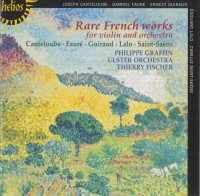 The wonderful Philippe Graffin is back with another fascinating CD of little-known works. Last month it was English violin concertos, this time it’s Rare French Works for violin and orchestra, with Thierry Fischer conducting the Ulster Orchestra (Helios CDH55396). The works themselves may be little-known, but only Ernest Guiraud lacks stature as a composer. Fauré’s single-movement Violin Concerto in D minor is here – the second movement is lost, the third never written – as are Lalo’s three-movement Fantaisie norvegienne and his Guitarre, and Saint-Saëns’ Morceau de concert. The best surprises, though, are Guiraud’s beautiful two-movement Caprice, and Joseph Canteloube’s gorgeous Poème, the latter giving the lie to the composer’s apparent doubts about his melodic abilities. Graffin is superb throughout, with a rapid vibrato and a crystal-clear lustrous tone, dazzling in the higher registers, and with an obvious empathy for these seldom-heard but utterly delightful pieces. Recorded in 2001, this is apparently a re-issue of a 2002 disc; if you missed it the first time around, don’t make the same mistake this time.
The wonderful Philippe Graffin is back with another fascinating CD of little-known works. Last month it was English violin concertos, this time it’s Rare French Works for violin and orchestra, with Thierry Fischer conducting the Ulster Orchestra (Helios CDH55396). The works themselves may be little-known, but only Ernest Guiraud lacks stature as a composer. Fauré’s single-movement Violin Concerto in D minor is here – the second movement is lost, the third never written – as are Lalo’s three-movement Fantaisie norvegienne and his Guitarre, and Saint-Saëns’ Morceau de concert. The best surprises, though, are Guiraud’s beautiful two-movement Caprice, and Joseph Canteloube’s gorgeous Poème, the latter giving the lie to the composer’s apparent doubts about his melodic abilities. Graffin is superb throughout, with a rapid vibrato and a crystal-clear lustrous tone, dazzling in the higher registers, and with an obvious empathy for these seldom-heard but utterly delightful pieces. Recorded in 2001, this is apparently a re-issue of a 2002 disc; if you missed it the first time around, don’t make the same mistake this time.
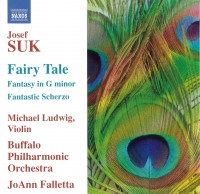 JoAnn Falletta and Michael Ludwig, conductor and concert-master respectively of the Buffalo Philharmonic Orchestra, combined for an outstanding Naxos CD of the Dohnanyi Violin Concertos a few years ago, and now they’re back with the music of Czech composer Josef Suk (1874-1935), this time with their own orchestra (Naxos 8.572323). Suk studied with Dvořák, who later became his father-in-law, and continued the Czech school of Dvořák and Smetana while managing to accommodate the influences of his contemporaries Mahler, Richard Strauss and Debussy. Ludwig is outstanding in the Fantasy for Violin and Orchestra in G minor, and also takes the solo line in the opening movement of the four-movement suite Pohadka (Fairy Tale), compiled from incidental music Suk wrote for a theatrical work in 1898. The orchestral Fantastic Scherzo in G minor rounds out another immensely satisfying CD from this terrific team.
JoAnn Falletta and Michael Ludwig, conductor and concert-master respectively of the Buffalo Philharmonic Orchestra, combined for an outstanding Naxos CD of the Dohnanyi Violin Concertos a few years ago, and now they’re back with the music of Czech composer Josef Suk (1874-1935), this time with their own orchestra (Naxos 8.572323). Suk studied with Dvořák, who later became his father-in-law, and continued the Czech school of Dvořák and Smetana while managing to accommodate the influences of his contemporaries Mahler, Richard Strauss and Debussy. Ludwig is outstanding in the Fantasy for Violin and Orchestra in G minor, and also takes the solo line in the opening movement of the four-movement suite Pohadka (Fairy Tale), compiled from incidental music Suk wrote for a theatrical work in 1898. The orchestral Fantastic Scherzo in G minor rounds out another immensely satisfying CD from this terrific team.
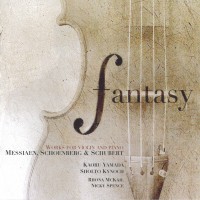 Fantasy is also the title of a new CD from the UK-based Japanese violinist Kaoru Yamada and pianist Sholto Kynoch (Stone Records 5060192780017) that features “Fantasy” works by Messiaen, Schoenberg and Schubert. The three Messiaen titles are early works springing from his relationship with the violinist Claire Delbos, with whom he toured in the early 1930s, and whom he married in 1932. La Mort du nombre, a setting of Messiaen’s own text, adds soprano and tenor to the duo; the influence of Fauré and Debussy is quite evident. Theme et variations is much more typical of Messiaen’s later (and instantly recognizable) style, with long, high melodic lines against steady, widely-spread piano chords and a wide dynamic range. Fantasie was believed lost, but recently discovered and published in 2007. Schoenberg’s Phantasy dates from 1949, and is typical late Schoenberg: assured, but technically challenging writing for both players. The two Schubert works seem a bit isolated after the fully committed performances of the 20th century material. The four-movement Fantasie has a set of variations based on Schubert’s own song, Sei mir gegrusst!, a somewhat pedestrian performance of the song itself ending the CD. Soprano Rhona McKail is the soloist for the latter, and is joined by tenor Nicky Spence in the Messiaen.
Fantasy is also the title of a new CD from the UK-based Japanese violinist Kaoru Yamada and pianist Sholto Kynoch (Stone Records 5060192780017) that features “Fantasy” works by Messiaen, Schoenberg and Schubert. The three Messiaen titles are early works springing from his relationship with the violinist Claire Delbos, with whom he toured in the early 1930s, and whom he married in 1932. La Mort du nombre, a setting of Messiaen’s own text, adds soprano and tenor to the duo; the influence of Fauré and Debussy is quite evident. Theme et variations is much more typical of Messiaen’s later (and instantly recognizable) style, with long, high melodic lines against steady, widely-spread piano chords and a wide dynamic range. Fantasie was believed lost, but recently discovered and published in 2007. Schoenberg’s Phantasy dates from 1949, and is typical late Schoenberg: assured, but technically challenging writing for both players. The two Schubert works seem a bit isolated after the fully committed performances of the 20th century material. The four-movement Fantasie has a set of variations based on Schubert’s own song, Sei mir gegrusst!, a somewhat pedestrian performance of the song itself ending the CD. Soprano Rhona McKail is the soloist for the latter, and is joined by tenor Nicky Spence in the Messiaen.
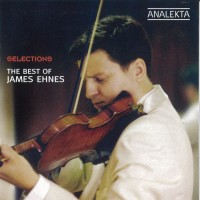 I certainly wasn’t expecting a Best of James Ehnes CD, but that’s what Analekta has given us with SELECTIONS (AN 2 9768), consisting entirely of material from previous Ehnes CDs. The Saint-Saëns Havanaise and Introduction & Rondo Capriccioso, and the Massenet Meditation are the only sizeable complete works; everything else is basically snippets of Bach, Dvořák and Kreisler. Presumably the hope is that if you like this, you’ll rush out and buy the previous CDs, but if you do really like Ehnes then you’ve probably already got them. Well, at least they didn’t call it James Ehnes’ Greatest Hits.
I certainly wasn’t expecting a Best of James Ehnes CD, but that’s what Analekta has given us with SELECTIONS (AN 2 9768), consisting entirely of material from previous Ehnes CDs. The Saint-Saëns Havanaise and Introduction & Rondo Capriccioso, and the Massenet Meditation are the only sizeable complete works; everything else is basically snippets of Bach, Dvořák and Kreisler. Presumably the hope is that if you like this, you’ll rush out and buy the previous CDs, but if you do really like Ehnes then you’ve probably already got them. Well, at least they didn’t call it James Ehnes’ Greatest Hits.
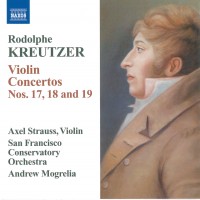 In these days of specialized instrumental soloists we tend to forget that for hundreds of years virtually all of the major violin virtuosi were also quite competent – and sometimes outstanding – composers: Vivaldi, Corelli, Tartini, Viotti, Paganini, Joachim, Hubay, Vieuxtemps, Sarasate, Spohr, Wieniawski, Ysaÿe, Kreisler, Enescu… and that’s only a partial list. Most violinists know the music of Rodolphe Kreutzer (1766-1831) only as students grappling with his Etudes, although his name is more famously attached to the Beethoven Op.47 Sonata, which Beethoven dedicated to him. Kreutzer, along with Viotti and Rode, was in at the start of the French violin concerto in the early 1780s, and Naxos has issued a CD of his last three Violin Concertos, Nos. 17-19, with the US-based German violinist Axel Strauss and the San Francisco Conservatory Orchestra under Andrew Mogrelia (8.570380). No.17, in G major, is quite brief and sounds a lot like Paganini without the fireworks. No.18, in E minor, is more substantial, but in much the same vein, and No.19, in D minor, is somewhat reminiscent of Schumann and Mendelssohn. Axel Strauss does as well as you can possibly expect with material that, truth be told, does not immediately strike you as being anything other than wholly competent. The booklet notes tell us that “Kreutzer’s final three violin concertos are among his greatest achievements as a composer;” one is tempted to wonder what the other 16 are like. Apparently, we’ll be able to find out: Naxos plans to record all of them. Gulp.
In these days of specialized instrumental soloists we tend to forget that for hundreds of years virtually all of the major violin virtuosi were also quite competent – and sometimes outstanding – composers: Vivaldi, Corelli, Tartini, Viotti, Paganini, Joachim, Hubay, Vieuxtemps, Sarasate, Spohr, Wieniawski, Ysaÿe, Kreisler, Enescu… and that’s only a partial list. Most violinists know the music of Rodolphe Kreutzer (1766-1831) only as students grappling with his Etudes, although his name is more famously attached to the Beethoven Op.47 Sonata, which Beethoven dedicated to him. Kreutzer, along with Viotti and Rode, was in at the start of the French violin concerto in the early 1780s, and Naxos has issued a CD of his last three Violin Concertos, Nos. 17-19, with the US-based German violinist Axel Strauss and the San Francisco Conservatory Orchestra under Andrew Mogrelia (8.570380). No.17, in G major, is quite brief and sounds a lot like Paganini without the fireworks. No.18, in E minor, is more substantial, but in much the same vein, and No.19, in D minor, is somewhat reminiscent of Schumann and Mendelssohn. Axel Strauss does as well as you can possibly expect with material that, truth be told, does not immediately strike you as being anything other than wholly competent. The booklet notes tell us that “Kreutzer’s final three violin concertos are among his greatest achievements as a composer;” one is tempted to wonder what the other 16 are like. Apparently, we’ll be able to find out: Naxos plans to record all of them. Gulp.
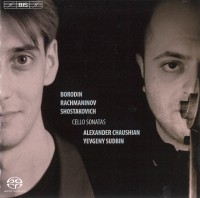 Armenian cellist Alexander Chaushian is teamed with Russian pianist Yevgeny Sudbin on a hybrid SACD of Russian Cello Sonatas (BIS-SACD-1858), featuring works by Rachmaninov, Shostakovich and Borodin. Their playing has the strength, warmth and conviction that these pieces need, and they are beautifully recorded. The balance felt a bit “pro-piano” at first, but it only served to underline that these are piano/cello duos, and not solo cello pieces with piano accompaniment. Rachmaninov’s G minor sonata opens the disc, and his Vocalise closes it. In between we have two works that couldn’t be more different. The Borodin Sonata in B minor is a real oddity: the manuscript, apparently, has survived only in “fragmentary form” and this performance is of the version completed by Russian composer and musicologist Mikhail Goldstein in 1982, “with a slightly abbreviated finale” whatever that means. How much is Borodin, and how much Goldstein, who knows? An earlier Goldstein “discovery” turned out to be his own work. What’s more, the material itself is quite strange. While doing post-doctoral scientific research in Heidelberg around 1860, Borodin lived next door to a violinist who kept playing the Bach G minor unaccompanied violin sonata; the fugue subject fascinated Borodin, and it forms the basis for the cello sonata, appearing in each of the three movements – in fact, it starts the first and third movements. The second movement, however, opens as pure Norwegian Grieg! Quite a stylistic feat. The Shostakovich D minor sonata, his first major chamber work, points the way to the composer’s future in more ways than one: written in 1934, it hints at the distinctive style that was to come, but it was also the work Shostakovich was touring with the cellist Viktor Kubatsky in 1936 when Pravda printed the attack on his music that would forever change his life.
Armenian cellist Alexander Chaushian is teamed with Russian pianist Yevgeny Sudbin on a hybrid SACD of Russian Cello Sonatas (BIS-SACD-1858), featuring works by Rachmaninov, Shostakovich and Borodin. Their playing has the strength, warmth and conviction that these pieces need, and they are beautifully recorded. The balance felt a bit “pro-piano” at first, but it only served to underline that these are piano/cello duos, and not solo cello pieces with piano accompaniment. Rachmaninov’s G minor sonata opens the disc, and his Vocalise closes it. In between we have two works that couldn’t be more different. The Borodin Sonata in B minor is a real oddity: the manuscript, apparently, has survived only in “fragmentary form” and this performance is of the version completed by Russian composer and musicologist Mikhail Goldstein in 1982, “with a slightly abbreviated finale” whatever that means. How much is Borodin, and how much Goldstein, who knows? An earlier Goldstein “discovery” turned out to be his own work. What’s more, the material itself is quite strange. While doing post-doctoral scientific research in Heidelberg around 1860, Borodin lived next door to a violinist who kept playing the Bach G minor unaccompanied violin sonata; the fugue subject fascinated Borodin, and it forms the basis for the cello sonata, appearing in each of the three movements – in fact, it starts the first and third movements. The second movement, however, opens as pure Norwegian Grieg! Quite a stylistic feat. The Shostakovich D minor sonata, his first major chamber work, points the way to the composer’s future in more ways than one: written in 1934, it hints at the distinctive style that was to come, but it was also the work Shostakovich was touring with the cellist Viktor Kubatsky in 1936 when Pravda printed the attack on his music that would forever change his life.



